First time: to the premiere of the film
On April 6, 2017, the film “ Time of the First ” about the space flight of Pavel Belyaev and Alexei Leonov is released. Then we will find out whether the collaboration with the co - star of the launch of Voskhod-2 , Viktor Blagov, and the visual effects studio CGF, which worked on Hardcore and The Crew , helped the filmmakers.
And for us it is a reason to remember the events of 1965, when a man first went into outer space, and then ran from bears through the taiga (in fact, not).
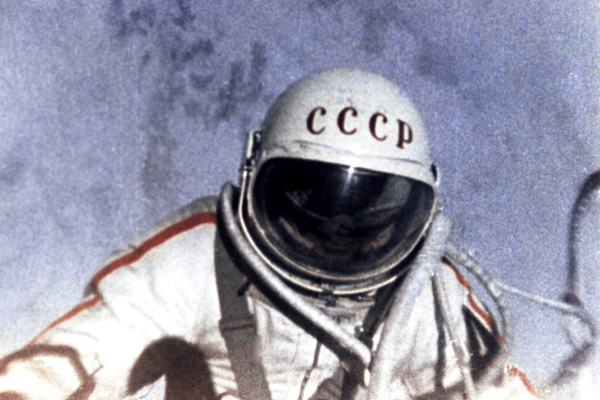
Pavel Ivanovich Belyaev was born on June 26, 1925 in the village of Chelishchevo, which now belongs to the Vologda region. In 1942, after 10 classes in secondary school, Belyaev got a job as a turner at the Sinarsky Pipe Plant, and in 1943 enrolled in the Soviet Army and went to the Yeysk Military Aviation Pilot School.
')
He participated in combat operations with Japan as a fighter pilot, and then served in the Soviet Navy. In 1959, Belyaev graduated from the Air Force Academy . During the service, the future astronaut mastered U-2, U-2, Yak-7B, Yak-9, Yak-11, La-11, MiG-15 and MiG-17, during which he flew more than 500 hours.
Alexey Leonov was younger than his flight colleague by 9 years. He was born in Siberia on May 30, 1934 and was the eighth child in the family. Father Leonov was repressed in 1937, the family with the mother’s pregnant ninth child was kicked out of the house. Neighbors looted the property of "enemies of the people." Leonov said in an interview in 2013: "Mom remembered, the neighbors took off my pants." The family moved to Kemerovo, and in 1939, when Father Leonov was rehabilitated, went to his place of work in Kaliningrad.
After graduating from high school in 1953, Leonov entered the 10th Military Aviation School of Primary Pilot Training in Kremenchug, and in 1957 the Chuguev Military Aviation School of Pilots.
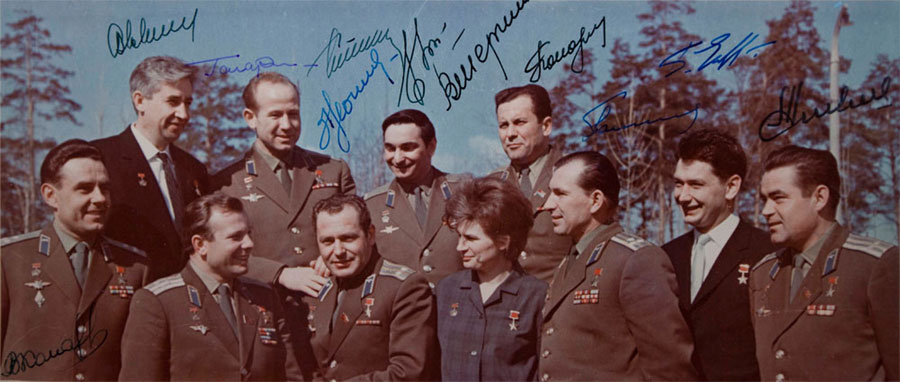
A source
On January 5, 1959, the CPSU Central Committee and the USSR Council of Ministers adopted a Resolution deciding on the selection and preparation of astronauts for the first space flight on the Vostok spacecraft. Officially, the squadron was called 1960: Air Force Group No. 1.
In the selection process, 3,461 potential fighter pilots were considered. Their number was first reduced to 347 people in order to conduct conversations and a primary medical examination, and then to 206 pilots who were admitted to the final inpatient examination. 105 people did not qualify for medical requirements, and 72 refused to be astronauts. As a result, there were 29 people left. Credentials committee of them selected 20 people.
Alexei Leonov was enrolled in the squad among the first twelve people on March 7, 1960. Pavel Belyaev was included in the list on April 28, he was the oldest in the team - he was 34 years old. As part of the squadron, future astronauts were trained for flying aboard the Vostok and Voskhod ships.

Pavel Belyaev and Alexey Leonov
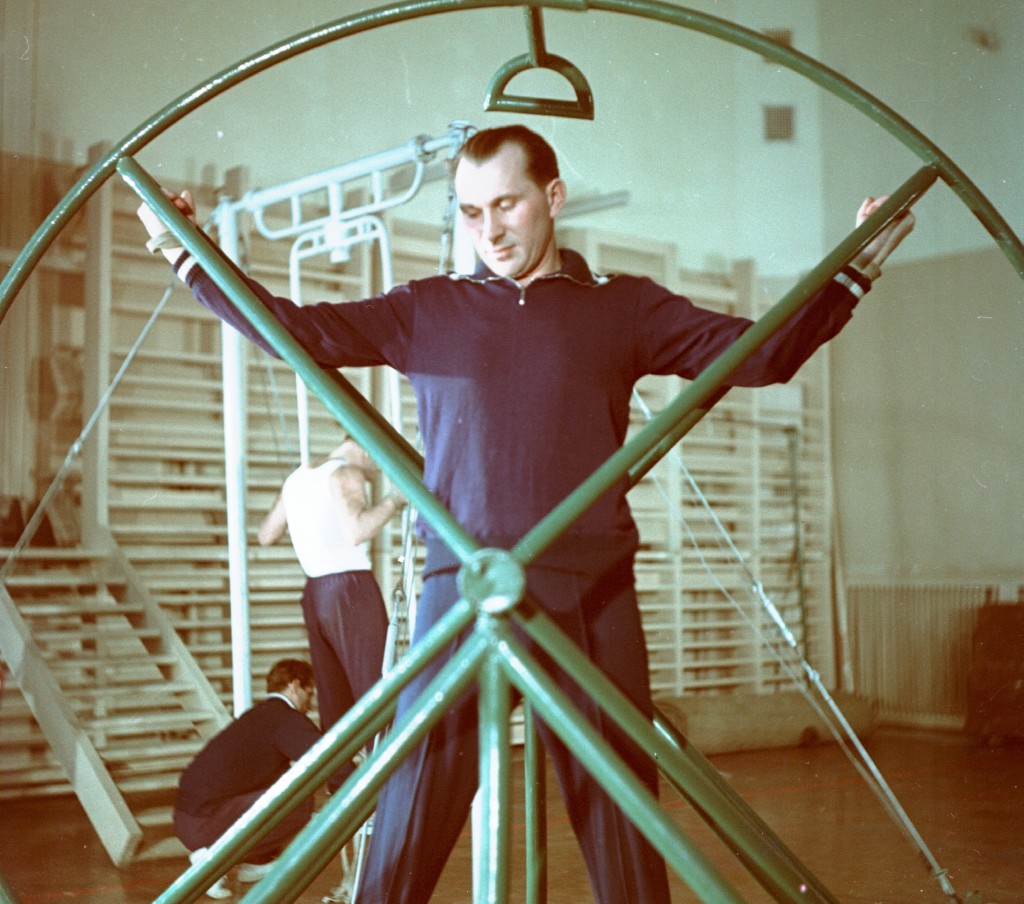
Pavel Belyaev

Alexey Leonov
The ships of the Vostok type, on one of which Yuri Gagarin went into space, were single-seater. "Sunrise" was a different version of the same ship. An ejection seat was removed from it to accommodate up to three ordinary ones. To ensure a soft landing, the descent vehicle was equipped with a solid-fuel brake motor, which is activated before touching the ground at the altimeter signal.
As part of this space program, the tasks of working out the interaction of crew members during the flight were solved. "Voskhod-1" was the first flight of a multi-seat spacecraft and the first flight without spacesuits - so saved space. The astronauts of Voskhod-2 had to be dressed in spacesuits after all, as they were planning to go out into space. Also, the astronauts took an inflatable airlock chamber with them.

Seating the seats in the ships "Vostok" and "Sunrise", NASA archives
On February 1, 1965, the crew of the Voskhod-2 was finally approved. The expedition commander was Pavel Belyaev. Pilot - Alexey Leonov. Substitutes were Viktor Gorbatko, Yevgeny Khrunov and Dmitry Zaikin. Before the start, the suits were worn only by the main crew and Khrunov, who could replace any crew member - both the pilot and the commander.
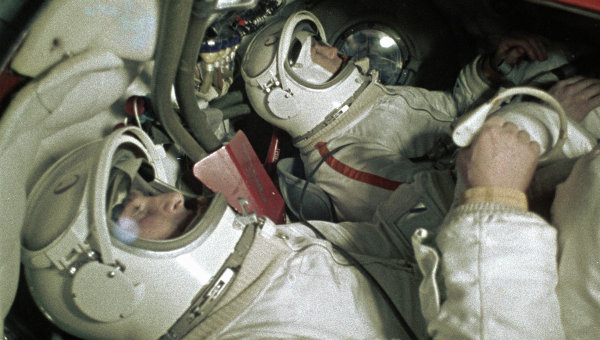
March 18, 1965 at 07:00 am GMT (or at 10:00 am Moscow time) the Voskhod-2 started from the Baikonur cosmodrome. The exit into orbit went smoothly. At the first turn, the astronauts inflated a lock chamber.
On the second turn, Belyaev opened the hatch from the console, Leonov in his spacesuit moved into the chamber, Belyaev closed the hatch and began depressurization. At 11:32:54 the commander opened the outer hatch, and the first man was in a space vacuum.

Render "Voskhoda-2" with inflated airlock, A. G. Shlyadinsky
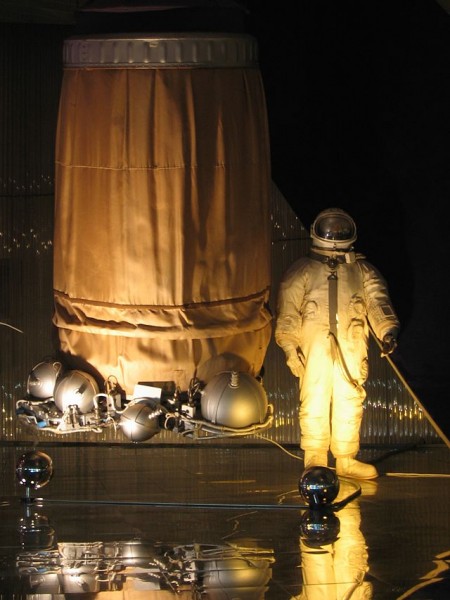
Spacewalk was a serious test for the body. The astronaut suffered from palpitations, the respiration rate was twice as high as normal, and hyperthermia reached +38 ° C. Leonov poured sweat. In the 1960s in the USSR, they were confident that an absolutely healthy person would feel normal in weightlessness. But any person perceives such loads in a different way, including mental loads, about which Tsiolkovsky spoke.
General Nikolai Kamanin, who was following the process from the Earth, wrote : “We watched his release on television, he smoothly“ hovered ”in space, waved us first with his left, and then with his right hand, turned over several times, departed and approached the ship . We saw him against the background of the Earth, 3-5 meters from the ship. ”
Today, the astronauts are trying to be closer to the ship's hull, and then Leonov several times the entire length of the halyard, 5.35 meters, departed from the ship. Fal managed to roll up to get back to the gateway.
But getting into the ship turned out to be a daunting task. For the mission in the NGO Zvezda, they developed a spacesuit, the Golden Eagle, which maintained a pressure of 0.4 atmospheres inside. In space, the spacesuit swelled. In violation of all the rules, Leonov did not report the situation, but he arbitrarily reduced the pressure in the spacesuit almost twice, to 0.27 atm, and entered the gateway, not feet first, but his head.
Reduced pressure could cause decompression sickness . The astronaut understood this, but still ventured. He had no choice. Fortunately, Leonov breathed pure oxygen, and there was practically no nitrogen left in his body.
The hatch opened in the ship and ate a large amount of its volume, therefore it was necessary to enter only with feet inside. Leonov had to make a tumble inside the airlock: "I am one hundred and ninety in a spacesuit, and the airlock is twenty meters in diameter, it had to be folded twice." As soon as the astronaut entered the ship, even before the entrance hatch was closed, he took off his helmet and rubbed his eyes because of the sweat poured over them.
On Earth, Sergei Pavlovich Korolev asked Leonov why he went to violations. Leonov recalls : “Look. I report to you, I have problems. You start to form a commission necessarily. They will start asking me. And I have five minutes left to enter the shadow and thirty minutes of life ... Of course, they would begin to ask me how and what. And I already died. " Then Korolev, as Leonov says, said: "And Lyosha is right."
According to the plan, after returning on board the astronaut, it was necessary to shoot the airlock. There were no problems with this. But as a result of temperature deformations, a gap was formed in the manhole, and the depressurization caused an increase in the oxygen supply to the life support system. This could lead to an explosion. Leonov accidentally touched the air supply switch from the reserve cylinders, and in the next seven hours the leak was stopped due to the reverse deformation, in fact, squeezing the hull elements by overpressure.
For Pavel Belyaev, there were also difficulties in flight. Already during the spacewalk, Leonov noticed that the ship did not hold orientation. Automatics failed. Belyaev transferred control to manual mode. It was impossible to control the ship from the chair, so the commander unbuckled, guided the ship and prepared to turn on the brake engine, returned to the chair and buckled up. Only after that the ship began to perform all the actions planned for landing.
The landing took place in snowy taiga 200 kilometers from Perm. In 2005, Leonov said : “We walked over Moscow, the inclination was 65. It was necessary to sit on this coil, and we ourselves chose the area for landing - 150 km from Solikamsk with a course angle of 270, because there was taiga. No businesses, no power lines. Could sit in Kharkov, Kazan, in Moscow, but it was dangerous. The version that we got there because of the imbalance is complete nonsense. We chose the landing site ourselves, since it was safer and possible deviations in the engine's operation shifted the landing point to safe areas too. Only in China it was impossible to sit down - then the relationship was very tense. As a result, at a speed of 28,000 km / h, we sat down just 80 km from us as the same calculated point. This is a good result. A backup landing sites then was not. And we were not expected there ... "
Taiga is a dangerous place, a wolverine is found in the Perm region, there are bears and lynxes. Since the flight of Yuri Gagarin, the Makarov pistol was part of a portable emergency reserve. “All that could have been done with the help of Makarov was to shoot himself,” said Alexei Leonov.
The first night the astronauts were sitting in the snow-covered taiga in space suits, since they did not have any other clothes. To warm up, we had to build a “garment” out of a jumble from the skin of the ship's screen-vacuum insulation and parachute lines. Nikolai Kamanin described further events: “Early in the morning of March 20, a helicopter flew over the landing site:“ I see two people at the ship, one cuts firewood, the other puts them into a fire, both are dressed in flight uniforms. ” At 7:30, Colonel Sibiryakov disembarked from a Mi-4 helicopter (1.5 meters hovering) about one and a half kilometers from the astronauts, with him the doctor Mists and a technician. At 8:30 they went on a ski to astronauts. In the same area, helicopters landed a few more people who began clearing the site for the helicopter landing. ”
The astronauts traveled to the helicopter already on skis along with rescuers. Interestingly in an artistic manner these events are described in an article in 1980 published in Around the World.
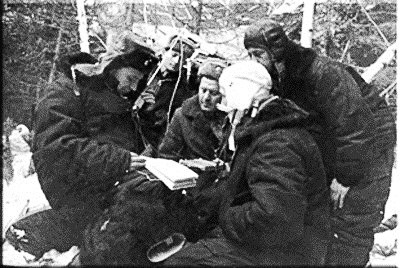
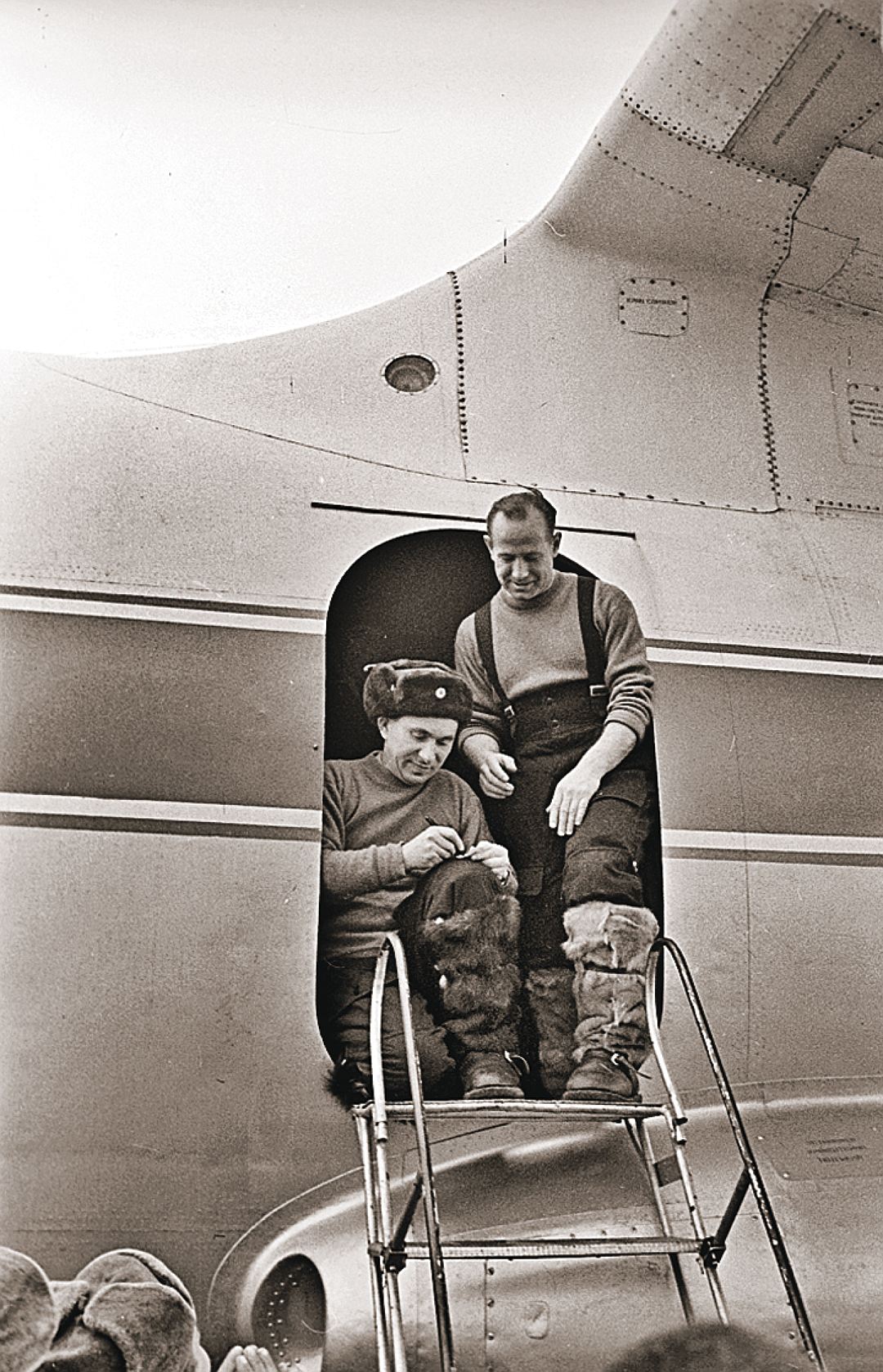
Return to Baikonur
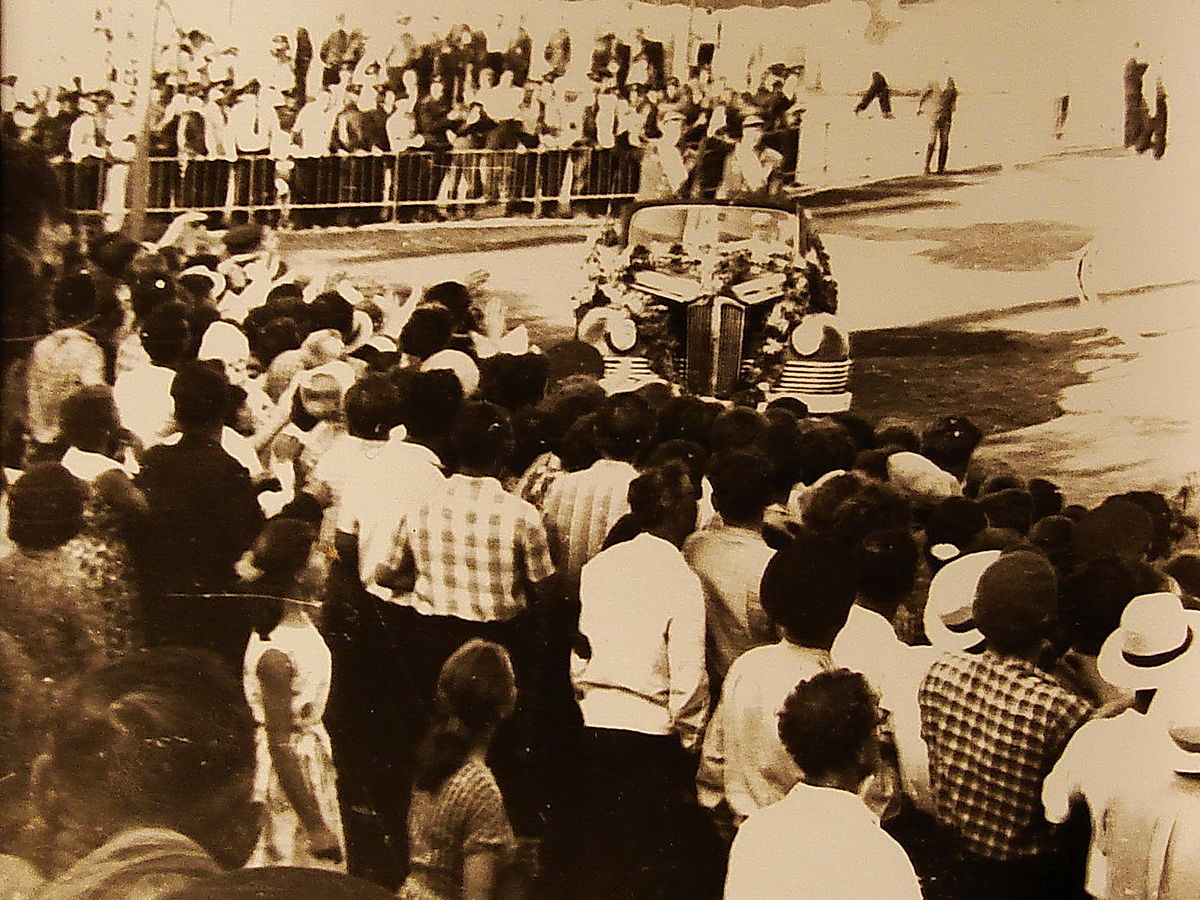
Honoring the cosmonauts P. I. Belyaev and A. A. Leonov in Vologda, Pavel Sergeyev

Tribune of the Mausoleum: Valentina Tereshkova, Yuri Gagarin, Alexey Leonov, Pavel Belyaev. TASS photo archive
A monument with the names of astronauts and Leonov's quotation is set up at the landing site: “Only such a soft earth, on which people live with a kind soul, could accept so gently a spacecraft that was approaching Earth at a speed of 8 km / s. By your spirituality, energy, inner conviction, by the scope of your soul, you are above many nations that flourish in material well-being. You live a beautiful, Russian, northern life. Thank you for that!"
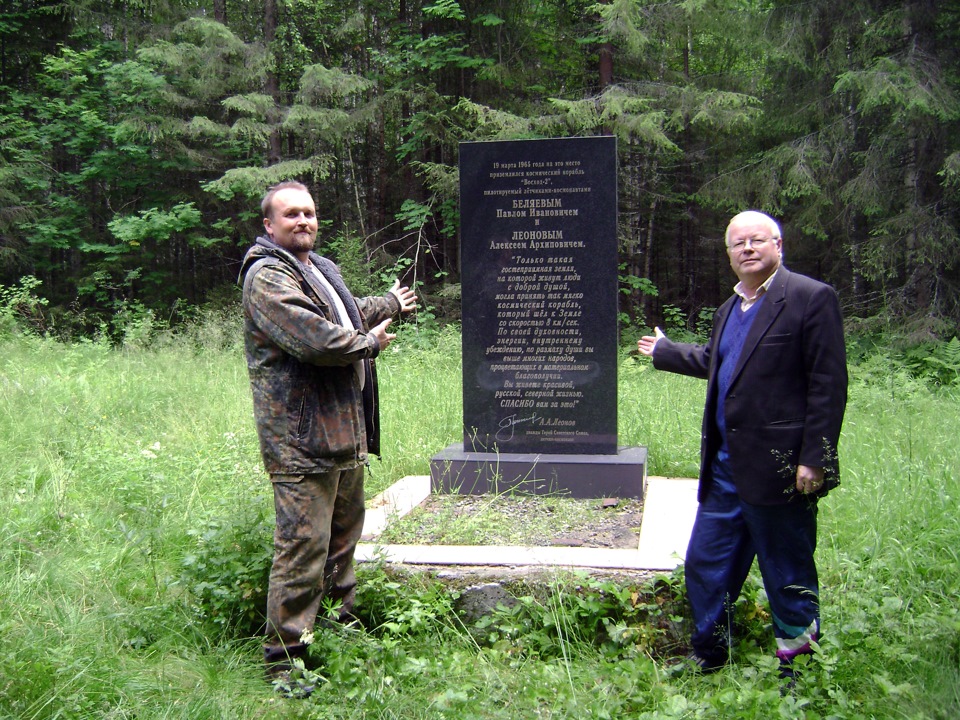
reamhunter
10 years later, Leonov returned to space as part of the Soyuz-19 expedition and made the first international space flight with docking with the American Apollo spacecraft, where he shook hands with Thomas Stafford. Stafford will call his grandson in honor of Leonov - Alexey, and Leonov’s granddaughter - Karina in honor of Stafford's daughter.
Pavel Belyaev, unfortunately, did not live to this point. January 10, 1970, he died of peritonitis. Apollo 15 Commander David Scott August 1, 1971, secretly from NASA, installed the Fallen Astronaut sculpture on the Moon. Next to the cosmonaut's 8.5-centimeter figure in a spacesuit, made by artist Paul Van Heydonkom, Scott placed a plaque with the names of eight American astronauts and six Soviet cosmonauts in alphabetical order. On one of the lines of the memorial plaque is Pavel Belyaev.
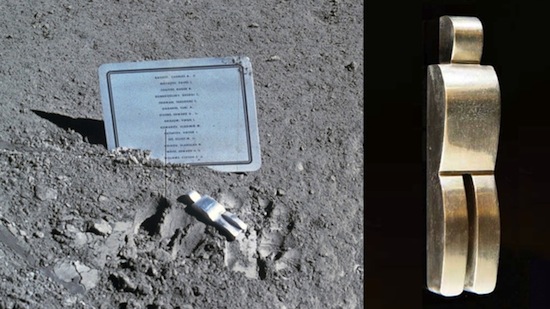
Today, 26 hours in orbit seem to be not a very remarkable result, just like 12 minutes in outer space. But it was the first 12 minutes. No one knew what to expect from them. The number of unexpected turns and sharp moments that occurred during the flight, envy many films. It would seem that you don’t even need to write the script, take the stories of the participants of the event, arrange them in chronological order and start shooting. But the movie, based on real events, is done differently. It remains to wait for the premiere of the film, to watch it, and after that to draw some conclusions.
And for us it is a reason to remember the events of 1965, when a man first went into outer space, and then ran from bears through the taiga (in fact, not).

Characters
Pavel Ivanovich Belyaev was born on June 26, 1925 in the village of Chelishchevo, which now belongs to the Vologda region. In 1942, after 10 classes in secondary school, Belyaev got a job as a turner at the Sinarsky Pipe Plant, and in 1943 enrolled in the Soviet Army and went to the Yeysk Military Aviation Pilot School.
')
He participated in combat operations with Japan as a fighter pilot, and then served in the Soviet Navy. In 1959, Belyaev graduated from the Air Force Academy . During the service, the future astronaut mastered U-2, U-2, Yak-7B, Yak-9, Yak-11, La-11, MiG-15 and MiG-17, during which he flew more than 500 hours.
Alexey Leonov was younger than his flight colleague by 9 years. He was born in Siberia on May 30, 1934 and was the eighth child in the family. Father Leonov was repressed in 1937, the family with the mother’s pregnant ninth child was kicked out of the house. Neighbors looted the property of "enemies of the people." Leonov said in an interview in 2013: "Mom remembered, the neighbors took off my pants." The family moved to Kemerovo, and in 1939, when Father Leonov was rehabilitated, went to his place of work in Kaliningrad.
After graduating from high school in 1953, Leonov entered the 10th Military Aviation School of Primary Pilot Training in Kremenchug, and in 1957 the Chuguev Military Aviation School of Pilots.

A source
Prehistory
On January 5, 1959, the CPSU Central Committee and the USSR Council of Ministers adopted a Resolution deciding on the selection and preparation of astronauts for the first space flight on the Vostok spacecraft. Officially, the squadron was called 1960: Air Force Group No. 1.
In the selection process, 3,461 potential fighter pilots were considered. Their number was first reduced to 347 people in order to conduct conversations and a primary medical examination, and then to 206 pilots who were admitted to the final inpatient examination. 105 people did not qualify for medical requirements, and 72 refused to be astronauts. As a result, there were 29 people left. Credentials committee of them selected 20 people.
Alexei Leonov was enrolled in the squad among the first twelve people on March 7, 1960. Pavel Belyaev was included in the list on April 28, he was the oldest in the team - he was 34 years old. As part of the squadron, future astronauts were trained for flying aboard the Vostok and Voskhod ships.

Pavel Belyaev and Alexey Leonov

Pavel Belyaev

Alexey Leonov
Flight
The ships of the Vostok type, on one of which Yuri Gagarin went into space, were single-seater. "Sunrise" was a different version of the same ship. An ejection seat was removed from it to accommodate up to three ordinary ones. To ensure a soft landing, the descent vehicle was equipped with a solid-fuel brake motor, which is activated before touching the ground at the altimeter signal.
As part of this space program, the tasks of working out the interaction of crew members during the flight were solved. "Voskhod-1" was the first flight of a multi-seat spacecraft and the first flight without spacesuits - so saved space. The astronauts of Voskhod-2 had to be dressed in spacesuits after all, as they were planning to go out into space. Also, the astronauts took an inflatable airlock chamber with them.

Seating the seats in the ships "Vostok" and "Sunrise", NASA archives
On February 1, 1965, the crew of the Voskhod-2 was finally approved. The expedition commander was Pavel Belyaev. Pilot - Alexey Leonov. Substitutes were Viktor Gorbatko, Yevgeny Khrunov and Dmitry Zaikin. Before the start, the suits were worn only by the main crew and Khrunov, who could replace any crew member - both the pilot and the commander.

March 18, 1965 at 07:00 am GMT (or at 10:00 am Moscow time) the Voskhod-2 started from the Baikonur cosmodrome. The exit into orbit went smoothly. At the first turn, the astronauts inflated a lock chamber.
On the second turn, Belyaev opened the hatch from the console, Leonov in his spacesuit moved into the chamber, Belyaev closed the hatch and began depressurization. At 11:32:54 the commander opened the outer hatch, and the first man was in a space vacuum.

Render "Voskhoda-2" with inflated airlock, A. G. Shlyadinsky

Spacewalk was a serious test for the body. The astronaut suffered from palpitations, the respiration rate was twice as high as normal, and hyperthermia reached +38 ° C. Leonov poured sweat. In the 1960s in the USSR, they were confident that an absolutely healthy person would feel normal in weightlessness. But any person perceives such loads in a different way, including mental loads, about which Tsiolkovsky spoke.
General Nikolai Kamanin, who was following the process from the Earth, wrote : “We watched his release on television, he smoothly“ hovered ”in space, waved us first with his left, and then with his right hand, turned over several times, departed and approached the ship . We saw him against the background of the Earth, 3-5 meters from the ship. ”
Today, the astronauts are trying to be closer to the ship's hull, and then Leonov several times the entire length of the halyard, 5.35 meters, departed from the ship. Fal managed to roll up to get back to the gateway.
But getting into the ship turned out to be a daunting task. For the mission in the NGO Zvezda, they developed a spacesuit, the Golden Eagle, which maintained a pressure of 0.4 atmospheres inside. In space, the spacesuit swelled. In violation of all the rules, Leonov did not report the situation, but he arbitrarily reduced the pressure in the spacesuit almost twice, to 0.27 atm, and entered the gateway, not feet first, but his head.
Reduced pressure could cause decompression sickness . The astronaut understood this, but still ventured. He had no choice. Fortunately, Leonov breathed pure oxygen, and there was practically no nitrogen left in his body.
The hatch opened in the ship and ate a large amount of its volume, therefore it was necessary to enter only with feet inside. Leonov had to make a tumble inside the airlock: "I am one hundred and ninety in a spacesuit, and the airlock is twenty meters in diameter, it had to be folded twice." As soon as the astronaut entered the ship, even before the entrance hatch was closed, he took off his helmet and rubbed his eyes because of the sweat poured over them.
On Earth, Sergei Pavlovich Korolev asked Leonov why he went to violations. Leonov recalls : “Look. I report to you, I have problems. You start to form a commission necessarily. They will start asking me. And I have five minutes left to enter the shadow and thirty minutes of life ... Of course, they would begin to ask me how and what. And I already died. " Then Korolev, as Leonov says, said: "And Lyosha is right."
According to the plan, after returning on board the astronaut, it was necessary to shoot the airlock. There were no problems with this. But as a result of temperature deformations, a gap was formed in the manhole, and the depressurization caused an increase in the oxygen supply to the life support system. This could lead to an explosion. Leonov accidentally touched the air supply switch from the reserve cylinders, and in the next seven hours the leak was stopped due to the reverse deformation, in fact, squeezing the hull elements by overpressure.
For Pavel Belyaev, there were also difficulties in flight. Already during the spacewalk, Leonov noticed that the ship did not hold orientation. Automatics failed. Belyaev transferred control to manual mode. It was impossible to control the ship from the chair, so the commander unbuckled, guided the ship and prepared to turn on the brake engine, returned to the chair and buckled up. Only after that the ship began to perform all the actions planned for landing.
The landing took place in snowy taiga 200 kilometers from Perm. In 2005, Leonov said : “We walked over Moscow, the inclination was 65. It was necessary to sit on this coil, and we ourselves chose the area for landing - 150 km from Solikamsk with a course angle of 270, because there was taiga. No businesses, no power lines. Could sit in Kharkov, Kazan, in Moscow, but it was dangerous. The version that we got there because of the imbalance is complete nonsense. We chose the landing site ourselves, since it was safer and possible deviations in the engine's operation shifted the landing point to safe areas too. Only in China it was impossible to sit down - then the relationship was very tense. As a result, at a speed of 28,000 km / h, we sat down just 80 km from us as the same calculated point. This is a good result. A backup landing sites then was not. And we were not expected there ... "
Taiga is a dangerous place, a wolverine is found in the Perm region, there are bears and lynxes. Since the flight of Yuri Gagarin, the Makarov pistol was part of a portable emergency reserve. “All that could have been done with the help of Makarov was to shoot himself,” said Alexei Leonov.
The first night the astronauts were sitting in the snow-covered taiga in space suits, since they did not have any other clothes. To warm up, we had to build a “garment” out of a jumble from the skin of the ship's screen-vacuum insulation and parachute lines. Nikolai Kamanin described further events: “Early in the morning of March 20, a helicopter flew over the landing site:“ I see two people at the ship, one cuts firewood, the other puts them into a fire, both are dressed in flight uniforms. ” At 7:30, Colonel Sibiryakov disembarked from a Mi-4 helicopter (1.5 meters hovering) about one and a half kilometers from the astronauts, with him the doctor Mists and a technician. At 8:30 they went on a ski to astronauts. In the same area, helicopters landed a few more people who began clearing the site for the helicopter landing. ”
The astronauts traveled to the helicopter already on skis along with rescuers. Interestingly in an artistic manner these events are described in an article in 1980 published in Around the World.


Return to Baikonur

Honoring the cosmonauts P. I. Belyaev and A. A. Leonov in Vologda, Pavel Sergeyev

Tribune of the Mausoleum: Valentina Tereshkova, Yuri Gagarin, Alexey Leonov, Pavel Belyaev. TASS photo archive
A monument with the names of astronauts and Leonov's quotation is set up at the landing site: “Only such a soft earth, on which people live with a kind soul, could accept so gently a spacecraft that was approaching Earth at a speed of 8 km / s. By your spirituality, energy, inner conviction, by the scope of your soul, you are above many nations that flourish in material well-being. You live a beautiful, Russian, northern life. Thank you for that!"

reamhunter
10 years later, Leonov returned to space as part of the Soyuz-19 expedition and made the first international space flight with docking with the American Apollo spacecraft, where he shook hands with Thomas Stafford. Stafford will call his grandson in honor of Leonov - Alexey, and Leonov’s granddaughter - Karina in honor of Stafford's daughter.
Pavel Belyaev, unfortunately, did not live to this point. January 10, 1970, he died of peritonitis. Apollo 15 Commander David Scott August 1, 1971, secretly from NASA, installed the Fallen Astronaut sculpture on the Moon. Next to the cosmonaut's 8.5-centimeter figure in a spacesuit, made by artist Paul Van Heydonkom, Scott placed a plaque with the names of eight American astronauts and six Soviet cosmonauts in alphabetical order. On one of the lines of the memorial plaque is Pavel Belyaev.

Today, 26 hours in orbit seem to be not a very remarkable result, just like 12 minutes in outer space. But it was the first 12 minutes. No one knew what to expect from them. The number of unexpected turns and sharp moments that occurred during the flight, envy many films. It would seem that you don’t even need to write the script, take the stories of the participants of the event, arrange them in chronological order and start shooting. But the movie, based on real events, is done differently. It remains to wait for the premiere of the film, to watch it, and after that to draw some conclusions.
Source: https://habr.com/ru/post/402861/
All Articles